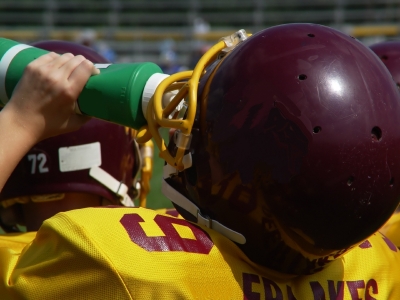In 2009, a joint task force of national sports medicine organizations, including the National Athletic Trainer's Association, the National Strength and Conditioning Association, and the American Academy of Pediatrics, published heat acclimatization guidelines (1) for high school pre-season practices [see box below]. The guidelines closely track mandatory guidelines adopted by the NCAA.

Six years later, only 13 state high school athletic associations (Arkansas, Arizona, Connecticut, New Jersey, Texas, Utah, Georgia, Mississippi, Florida, Iowa, Illinois, Missouri, and North Carolina) have made the guidelines mandatory, two jurisdictions (D.C. and West Virginia) have no guidelines in place, and 37 state high school athletic associations have adopted guidelines which depart substantially from those recommended by the joint task force, mandated by the NCAA Sports Medicine Board, and promoted by MomsTEAM and the Korey Stringer Institute (KSI) at the University of Connecticut, whose mission, from its inception, has to be prevent exertional heat stoke.
Indeed, the pace of adopting the guidelines has slowed to a stop. While KSI is working with 14 states to correct deficiencies in their guidelines, only one state (Alabama) has adopted the guidelines in 2014, down from five in both 2013 (Connecticut, Iowa, Missouri, Utah, and Mississippi) and 2012 (North Carolina, Georgia, Arkansas, Florida and Arizona). No state has adopted the guidelines since June 2014.
Excuses for inaction
With pre-season football practices underway in many states, we are left wondering: if pre-season heat-acclimatization is considered so essential by the NCAA that a violation can result in a fine or a post-season ban, why haven't more high school athletic associations followed suit, and why is Georgia the only association that imposes fines for violations?
Opponents appear to cite four principal reasons:
- School start dates vary by county;
- Concern that limiting time and practices will decrease competitiveness and fitness;
- Lack of coach support; and
- Limits on amount of practice time prior to game potentially increases risk of injury in games.
None of the cited reasons justify a failure to implement the guidelines, which can be achieved by anyone who slowly increases exercise duration and intensity across days. The majority of adaptations are made in 7 days, but a total of 14 days are needed for complete acclimatization. When it gets hotter outside or the intensity of exercise changes, the magnitude of adaptations needs to change as well.
How parents can help
Exertional heat stroke is one of the most preventable sports injuries. Indeed, KSI reports that, in the states in the which the guidelines have been adopted, there have been ZERO deaths due to heat stroke. Parents of youth athletes in states with no guidelines in place or guidelines considered deficient by KSI can help prevent exertional heat stroke by advocating for adoption of heat acclimatization guidelines. Here's how:
- Email or contact your state's board of medicine, the state high school athletic association, and the state athletic trainers' association. You can find your state's association on the National Federation of State High School Associations website. Provide them a hard or PDF copy of the guidelines and explain why you support adoption in your state;
- Advocate in favor of the guidelines at the pre-season meeting of stakeholders (parents/AD/coaches);
- Advocate in favor of the guidelines at a Booster Club meeting;
- Use our Advocacy Handout.
"Heat Acclimatization" is a term used to describe the physical adaptations the body uses to handle the heat. "Acclimatization" refers to the body making these adaptations in a natural outdoor environment. "Acclimation" refers to the same process but in a contrived environment (i.e. a laboratory heat chamber). Heat Acclimatization is essential for all athletes and active individuals to be safe while exercising in the heat.
The primary adaptations while exercising in the heat include:
| Adaptation |
Benefit |
| Decreased heart rate | Decreased cardiovascular strain |
| Decreased core temperature |
Increased heat storage capacity Increased ability to stay in the "safe zone" (under 104F) |
| Decreased perception of exertion | Decreased feelings of tiredness while exercising in the heat |
| Increased blood volume | Increased efficiency of the cardiovascular system |
| Increased exercise tolerance time | Increased exercise time in the heat safely |
| "Better sweater": Decreased salt lost in sweat |
Sodium can be used for other vital bodily functions The body holds onto water more efficiently Decreases the possibility of cramps |
| "Better sweater": Increased sweat rate |
Increased cooling through evaporation |
| "Better sweater"; Earlier sweating |
Allows a greater amount of heat to be dispersed from the body |
For a chart comparing NCAA and high school recommended guidelines, click here.
For a handout on heat acclimatization guidelines, click here.
The assistance of Rebecca Stearns of the Korey Stringer Institute in the preparation of this article is gratefully acknowledged.
Sources: Korey Stringer Institute, NCAA, MomsTEAM Youth Sports Safety Institute
1. Casa DJ, Csillan D. Preseason heat-acclimatization guidelines for secondary school athletics. J Athl Train. 2009;44(3):332-333.
Posted June 26, 2012; most recently revised July 21, 2015









